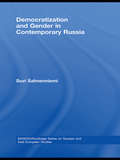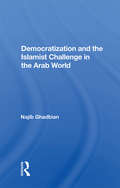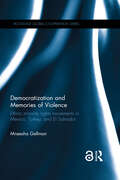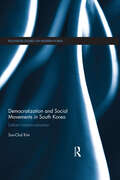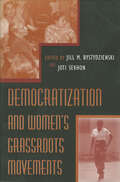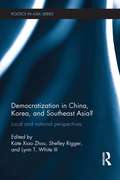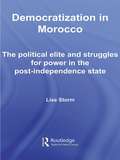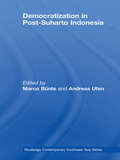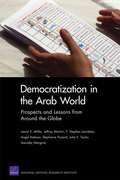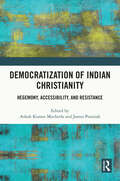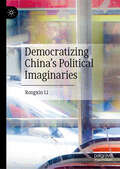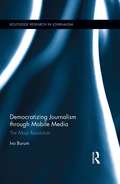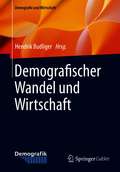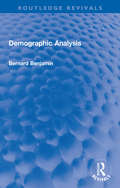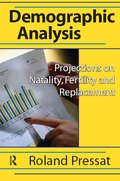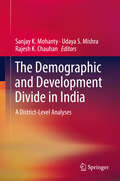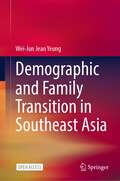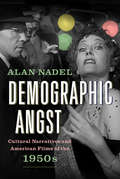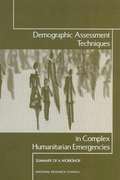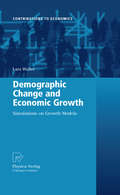- Table View
- List View
Democratization and Gender in Contemporary Russia (BASEES/Routledge Series on Russian and East European Studies #10)
by Suvi SalmenniemiThis book examines civic activism, democratization and gender in contemporary Russian society. It describes the character and central organizing principles of Russian democratic civic life, considering how it has developed since the Soviet period, and analyzing the goals and identities of important civic groups - including trade unions - and the meanings they have acquired in the context of wider Russian society. In particular, Suvi Salmenniemi investigates the gender dimensions, both masculine and feminine, of socio-political participation in Russia, considering what kinds of gendered meanings are given to civic organizations and formal politics, and how femininity and masculinity are represented in this context. Exploring the role of state institutions in the development of democratic civic life, the volume shows how, under the increasingly authoritarian Putin regime and its policy of ‘managed democracy’, independent civic activism is both thriving yet at the same constrained. Based on extensive fieldwork research, it provides much needed information on how Russians themselves view these developments, both from the perspective of civic activists and the local authorities.
Democratization And The Islamist Challenge In The Arab World
by Najib GhadbianThe rise of Islamic movements in the Arab world over the last decade coincided with a move toward democratization throughout the region, yet after hopeful early signs, progress toward democratization has stalled or has even been reversed in all but a few countries. This book explores the linkages between the move to democratize and the Islamist challenge, focusing on the struggle among ruling elites, secularists, and the Islamists to define collective identity—that is, to define what common orientations unite the polity and how disagreements can be addressed, particularly regarding the place of Islam in politics. The author surveys democratization measures since 1980 and analyzes the nature of the Islamist challenge, exploring the factors behind the rise of fundamentalism, the agendas of various Islamic movements, and Islamist concepts of democracy. In a final section the author offers in-depth case studies of Egypt and Jordan.
Democratization and Memories of Violence: Ethnic minority rights movements in Mexico, Turkey, and El Salvador (ISSN)
by Mneesha GellmanEthnic minority communities make claims for cultural rights from states in different ways depending on how governments include them in policies and practices of accommodation or assimilation. However, institutional explanations don’t tell the whole story, as individuals and communities also protest, using emotionally compelling narratives about past wrongs to justify their claims for new rights protections. Democratization and Memories of Violence: Ethnic minority rights movements in Mexico, Turkey, and El Salvador examines how ethnic minority communities use memories of state and paramilitary violence to shame states into cooperating with minority cultural agendas such as the right to mother tongue education. Shaming and claiming is a social movement tactic that binds historic violence to contemporary citizenship. Combining theory with empirics, the book accounts for how democratization shapes citizen experiences of interest representation and how memorialization processes challenge state regimes of forgetting at local, state, and international levels. Democratization and Memories of Violence draws on six case studies in Mexico, Turkey, and El Salvador to show how memory-based narratives serve as emotionally salient leverage for marginalized communities to facilitate state consideration of minority rights agendas.This book will be of interest to postgraduates and researchers in comparative politics, development studies, sociology, international studies, peace and conflict studies and area studies.
Democratization and Social Movements in South Korea: Defiant Institutionalization (Routledge Studies on Modern Korea)
by Sun-Chul KimSouth Korea provides an intellectual challenge in the fields of social movements and democracy in that intense mobilization and the strong influence of social movements have accompanied steady democratization for more than two decades, despite major theories having predicted otherwise. This book examines how social movements in previously authoritarian contexts evolve after democratic transition, using South Korea as a case study. It explores how democratic change influences the form of social movements, and how social movements affect the pace and direction of democracy in turn. It explains how South Korean social movements were able to attain strong political influence by focusing on four causal factors: the configuration of major political actors during the transition period, the relational dynamics among social movement groups, the relationship between social movements and institutionalized political actors, and the impact of transnational forces in the post-transition period. Unlike previous scholarship, the book takes a historical, actor-centered, and process-oriented approach that closely follows the interactions among contending actors through event sequences, rather than being driven by abstract theoretical frameworks. In doing so, it analyses uses a broad range of evidence, including police records, untapped activist documents, presidential memoirs, newspaper accounts and original data sets. Shedding light on the complex political reality that gave rise to a contentious civil society in South Korea after democratization, this book also illuminates the institutional conditions that can help promote domestic peace and stability. Therefore it will be of great use to students and scholars of Korean Studies, Korean politics and social movements, as well as policy makers.
Democratization and Women’s Grassroots Movements
by Jill M. Bystydzienski Joti SekhonThe book illustrates how community-based actions, programs, and organizations that allow women to determine their lives and participate in decision making contribute to the creation of a civil society and thus enhance democracy. The case studies show how participation in grassroots movements promotes women’s involvement in their organizations, communities, and in societal institutions, as it influences state policy and empowers women in personal relationships.
Democratization in China, Korea and Southeast Asia?: Local and National Perspectives (Politics in Asia)
by Kate Xiao Zhou Shelley Rigger Lynn T. WhiteRapid economic pluralization in East Asia has empowered local and medial groups, and with this change comes the need to rethink usual notions regarding ways in which "democracies" emerge or "citizens" gain more power. Careful examination of current developments in China, Korea, and Southeast Asia show a need for expansion of our understandings of democracy and democratization. This book challenges traditional ways in which political regimes in local as well as national polities are conceived and labeled. It shows from Asian experiences that democracy and its precursors come in more forms than most liberals have yet imagined. In reviewing recent experiences of countries across East Asia, these chapters show that actual democracies and ostensible democratizations there are less like those in the West than the surprisingly consensual and standard political science of democratization suggests. This book first examines the extreme variation of democracy’s meaning in many Asian states that hold contested elections (South Korea, Taiwan, Indonesia, Malaysia, the Philippines, and Thailand). Then it focuses on China. It analyzes a range of grassroots forces driving political change in the People’s Republic, and it finds both accelerators and brakes in China’s political reform process. The contributors show that models for China’s political future exist both within and outside the PRC, including in other East Asian states, in localities and sectors that already are pushing the limits of the powerful, but no longer all-powerful, Chinese party-state. With contributions from leading academics in the field, Democratization in China, Korea, and Southeast Asia? will be of interest to students and scholars of Asian politics, comparative politics, and democratization more broadly.
Democratization in Morocco: The Political Elite and Struggles for Power in the Post-Independence State (Routledge Studies in Middle Eastern Politics #Vol. 5)
by Lise StormThis book explores the political games of the Moroccan democratization process in the period from independence in 1956 until 2006. By combining a great degree of political theory with empirical material on Morocco, it analyzes the strategies and actions of the various political actors and evaluates the level of democracy present in the country after the adoption of new constitutions in 1962, 1970, 1972, 1980, 1992 and 1996. Lise Storm demonstrates that in at least some instances, democratization has been more than simply a survival strategy – every so often, key figures within the political elite have taken the democratization process further than strictly needed for them to stay in power. In the case of Morocco, it has been the monarch who on more than one occasion has moved the country further towards the democratic ideal than he necessarily had to, and that sometimes even against the wishes of one or more of the established political parties. This book illustrates how the Moroccan political parties, like so many of their counterparts in the region, have become the main obstacle to further democratization as most of them have never honoured – or appear to have abandoned – the key function of political parties: popular representation. Democratization in Morocco will be a very valuable contribution to students and researchers interested in the dynamics behind the Moroccan democratization and the role of electoral politics in North African and Middle Eastern politics.
Democratization in Post-Suharto Indonesia (Routledge Contemporary Southeast Asia Series)
by Marco Bünte Andreas UfenIn May 1998 the fall of Suharto marked the beginning of a difficult and multi-layered transition process. It was accompanied by intensified conflict in the political arena, a dramatic increase of ethnic and religious violence and the danger of national disintegration. Ten years after the collapse of the New Order, Indonesia has made significant progress, however the quality of democracy is still low. Theoretically innovative and empirically sound, this book is an in-depth analysis of the Indonesian reform process since 1998. Marco Bünte and Andreas Ufen bring together a selection of noted Indonesia experts to provide new insights into the restructuring of core state institutions, the empowerment of Parliament, the slow and difficult evolution of the rule of law, and the transfer of power to locally elected regional governments (decentralization). Based on the results of extensive fieldwork, Democratization in Post-Suharto Indonesia will be an important read for scholars engaged in research on Indonesia and the politics of Southeast Asia.
Democratization in the Arab World: Prospects and Lessons from Around the Globe
by Laurel E. Miller Jeffrey Martini F. Stephen Larrabee Angel Rabasa Stephanie Pezard Julie E. Taylor Tewodaj MengistuDaunting challenges lie ahead for Arab countries where revolutions have upended longstanding authoritarian regimes. This monograph aims to help policymakers understand the challenges ahead, form well-founded expectations, shape diplomatic approaches, and take practical steps to foster positive change.
Democratization of Indian Christianity: Hegemony, Accessibility, and Resistance
by Ashok Kumar Mocherla James PonniahThis book highlights the transformative potential of democratic Church and Christian community in India. In the light of both ongoing and, also to some extent, foregone sociopolitical and theological challenges confronting Indian Christianity, this book invokes the need to democratize Indian Christianity in terms of its theology, liturgy, teachings, practices, resources, leadership roles, and institutional power relations/sharing by keeping contemporary “social realities” of Indian Christians at the core of its approach and discourse. It explores internal challenges – of caste, class, gender, and regional contestations – and external forces of communalism and majoritarianism confronting Indian Christianity today. Further, it underlines the importance of dignity, equality, fraternity, freedom, and responsibility emerging at an organizational level through strong mechanisms of deliberation, decision-making, and execution. A major contribution to religious studies in India, this book will be of great interest to scholars and researchers of religion, especially Christian theology, South Asian studies, politics, and sociology.
Democratizing China’s Political Imaginaries
by Rongxin LiThis book offers a meticulous empirical examination of Chinese democracy and its myriad discourses. Delving into the intricate workings of Chinese democracy, the author explores how the Chinese Communist Party employs democratic principles, how intellectuals grapple with the concept, and how the populace perceives and engages with democracy. In transcending mere methodological nationalism, this narrative extends to the global stage, offering insights into democratic evolution beyond Western paradigms by exploring resonates particularly with developing and post-colonial countries, offering a fresh perspective on the delicate balance between state capacity, social order, and the democratization process. While the trajectory of democracy in China remains uncertain, these empirically grounded analyses provide a pragmatic lens through which to contemplate the future of Chinese political dynamics.
Democratizing Journalism through Mobile Media: The Mojo Revolution (Routledge Research in Journalism)
by Ivo BurumFuelled by a distrust of big media and the development of mobile technologies, the resulting convergence of journalism praxis (professional to alternative), workflows (analogue to multipoint digital) and platforms (PC to mobile), result in a 24-hour always-on content cycle. The information revolution is a paradigm shift in the way we develop and consume information, in particular the type we call news. While many see this cultural shift as ruinous, Burum sees it as an opportunity to utilize the converging information flow to create a galvanizing and common digital language across spheres of communication: community, education and mainstream media. Embracing the digital literacies researched in this book will create an information bridge with which to traverse journalism’s commercial precarity, the marginalization of some communities, and the journalism school curricula.
Democratizing the Enemy: The Japanese American Internment
by Brian Masaru HayashiDuring World War II some 120,000 Japanese Americans were forcibly removed from their homes and detained in concentration camps in several states. These Japanese Americans lost millions of dollars in property and were forced to live in so-called "assembly centers" surrounded by barbed wire fences and armed sentries. In this insightful and groundbreaking work, Brian Hayashi reevaluates the three-year ordeal of interred Japanese Americans. Using previously undiscovered documents, he examines the forces behind the U.S. government's decision to establish internment camps. His conclusion: the motives of government officials and top military brass likely transcended the standard explanations of racism, wartime hysteria, and leadership failure. Among the other surprising factors that played into the decision, Hayashi writes, were land development in the American West and plans for the American occupation of Japan. What was the long-term impact of America's actions? While many historians have explored that question, Hayashi takes a fresh look at how U.S. concentration camps affected not only their victims and American civil liberties, but also people living in locations as diverse as American Indian reservations and northeast Thailand.
Democrazia: guida dell'utente
by Joss SheldonDICONO CHE VIVIAMO IN UNA DEMOCRAZIA. SIAMO LIBERI E DOVREMMO ESSERNE GRATI. Ma quanto siamo “liberi”? Quanto sono democratiche le nostre cosiddette “democrazie”? Basta semplicemente eleggere i nostri leader e starcene seduti a guardare, impotenti, come questi ci governano come dittatori? A cosa serve scegliere i nostri politici se non possiamo controllare i media, la polizia o i soldati? Se dobbiamo seguire ciecamente gli ordini di maestri e capi, a scuola e sul lavoro, non è da ingenui credere che siamo padroni del nostro destino? E se le nostre risorse sono controllate da una ridotta cricca di plutocrati, banchieri e grandi imprese, possiamo dire in tutta onestà che l’economia viene gestita per noi? Le cose non potrebbero essere un po’ più… beh… democratiche? Certamente! “Democrazia: manuale dell’utente” ci mostra come… Nelle pagine di questo libro, ricche di storie, visiteremo la Summerhill, una scuola democratica nell’Inghilterra orientale; per poi fare tappa in Brasile per conoscere la Semco, dove la democrazia sul posto di lavoro la fa da padrone. Viaggeremo nel Rojava, per esplorare la vita in un esercito democratico, e poi ci dirigeremo verso la Spagna, per scoprire perché Podemos sta provando la democrazia liquida. Faremo in viaggio a ritroso nel tempo, per vedere le democrazie all’opera nelle società dei cacciatori-raccoglitori, nelle confederazioni tribali, nelle corporazioni e nei comuni. Esamineremo il caso del bilancio partecipativo, della democrazia deliberativa, dell’assunzione collaborativa, delle valute comunitarie, dei prestiti tra privati e molto altro ancora. Il messaggio è chiaro e conciso: la democrazia non dev’essere una chimera; abbiamo tutti gli strumenti che ci servono per governarci da soli.
Demodiversity: Toward Post-Abyssal Democracies (Epistemologies of the South)
by Boaventura de Sousa SantosWe are living in a time when social and political authoritarianism appear to be gaining ground around the world. This book presents the democratic practices, spaces and processes that engage directly with the theoretical assumptions advanced by the epistemologies of the South, summoning other contexts and empirical realities that attest to the possibility of a renewal and deepening of democracy beyond the liberal and representative canon, which is embedded within a world capitalist system. The chapters in this book put forward the ideas of demodiversity, of high-intensity democracy, of the articulation between representative democracy and participatory democracy as well as, in certain contexts, between both these and other forms of democratic deliberation, such as the communitarian democracy of the indigenous and peasant communities of Africa, Latin America and Asia. The challenge undertaken in this book is to demand utopia, imagining a post-abyssal democracy that permits the democratizing, decolonizing, decommodifying and depatriarchalizing of social relations. This post-abyssal democracy obliges us to satisfy the maximum definition of democracy and not the minimum, transforming society into fields of democratization that permeate the structural spaces of contemporary societies.
Demografischer Wandel und Wirtschaft (Demografie und Wirtschaft)
by Hendrik BudligerDemografie und demografischer Wandel betreffen uns alle. Dennoch ist das Thema viel zu wenig in unseren Köpfen und in der Öffentlichkeit präsent. Dieses Buch befasst sich mit den Auswirkungen des demografischen Wandels auf die Wirtschaft, wobei dies differenziert aus mehreren Perspektiven betrachtet wird. In verständlicher Sprache bieten die Autorinnen und Autoren aus Wissenschaft und Praxis fokussierte Einblicke in ihre Arbeit, um Erkenntnisse und Zusammenhänge zwischen der Demografie und der Wirtschaft zu diskutieren und um ihre jeweiligen Blickwinkel und Kompetenzen zu vermitteln. Es werden sowohl Problemfelder aufgezeigt, die erst im Entstehen sind, als auch Lösungsansätze für bereits bestehende Zusammenhänge vorgeschlagen. Neben verschiedenen Ursachen demografischen Wandels werden Auswirkungen der demografischen Entwicklung auf Nachfrage, Arbeitsmarkt, Rentenversicherung, Staatsfinanzen und den Klimawandel analysiert sowie die Covid-19-Pandemie und deren Auswirkung auf demografische Faktoren diskutiert. Dies ist der erste Band der Reihe Demografie und Wirtschaft.
Demographic Analysis (Routledge Revivals)
by Bernard BenjaminFirst published in 1968, Demographic Analysis was written to provide a comprehensive account of demographic methods for those with a need to understand population movements. The book provides an introduction to some of the key tools used by demographers and the principal sources of population data. Beginning with an overview of the scope, content and use of the population census, it then examines methods for measuring births, deaths, and migration before setting out the methodology for determining the contributions of these elements to population change and estimating past or future changes. The book also explores sickness as a population characteristic and a way of better understanding mortality variations.
Demographic Analysis: Projections on Natality, Fertility and Replacement
by Roland PressatPopulation control requires that the birth rate equal to the death rate. If it is too low population will decline; if it is too high, population will increase. If either condition persists long enough the population will diminish towards zero or increase towards infinity. Fortunately, the birth trajectory does not have to be set once and for all, but can be adjusted within limits. Since birth and death rates determine whether we are heading for population extinction or explosion, they are well designated "vital statistics." Their understanding and use are a central theme of demographic analysis."Demographic Analysis" presents those techniques that are often called for in the study of demographic problems. Such techniques permit researchers to fill the gap between the large amounts of data made available by censuses and the theoretical and practical questions that need to be answered; the techniques of this book effectively bring the data into confrontation with the problems. In his treatment of population projection, Pressat applies methods developed in earlier sections for mortality arid fertility. The emphasis is on population projection and accords with its usefulness in demographic analysis. The meaning of a demographic rate or trend is brought out by seeing to what condition it would lead if continued. No assumption is made that the concrete future will follow either path.The substance of the book is devoted to the main themes of mortality and fertility. Underlying these as well as nearly every other kind of data with which the demographer deals is the problem of location in time - the relation of vital events to the calendar, and also to the age of the persons undergoing them. Pressat's detailed attention to this problem forms a solid basis for how current methodology accounts of demographic changes.
Demographic Analysis of Latin American Immigrants in Spain
by Andreu Domingo Albert Sabater Richard R. VerdugoThis book provides a unique, timely and comprehensive insight into Latin American immigrants in Spain. Each chapter uses a demographic framework to examining important topics related to the experiences of Latin American immigrants in Spain, like their rapid acquisition of nationality, their contrasting patterns of migration and settlement compared to other immigrant groups, their labour market experiences before and during the economic recession, their reproductive behaviour before and after settling in Spain, as well as the push and pull factors of what is regarded as one of the single biggest waves of international migration ever experienced by Spain. Beyond the investigation of such pertinent topics, this book addresses issues relating to the adequacy of demographic theory in explaining the presence of Latin American immigrants in Spain, particularly the trailblazing presence of women among the immigrants. Spain unquestionably constitutes a good example of the fact that the future of demographic growth in post-transitional countries is mainly and irreversibly marked by the evolution of migratory movements, while the latter factor is closely linked with the economic state of affairs. In the short term at least, the causal relations go from economy to demography. In the long term, if economic growth is linked with demographic growth as some economists hypothesise, this would also be fundamental, not only in the sense of growth itself but also with regard to how this might be distributed.
The Demographic and Development Divide in India: A District-Level Analyses
by Sanjay K. Mohanty Udaya S. Mishra Rajesh K. ChauhanThis book is the first-ever volume which provides comprehensive information on demographic, health and development at the level of 640 districts in India. Central and state governments, developmental organizations, national and international NGOs and researchers require disaggregated data at the district level for many practical purposes. However, such information is not readily available for use. The editors, with a close-knit group of collaborators, have compiled data from reliable sources for each district of India and present the results in the form of composite indexes. The chapters rank districts within the state and vis-à-vis all districts of India to help readers understand intra-district and inter-district developmental disparities. They present spatial analyses that depict clustering of development. It is a ready reference for planners, researchers and students and provides scientific analyses that depict the clustering of development parameters at the district level. This volume is meant for a wide readership interested in development in India, across population studies, sociology, economics, statistics, to regional development, and from academics, researchers, and planners to policy makers.
Demographic and Family Transition in Southeast Asia
by Wei-Jun Jean YeungThis open access book presents the trends and patterns of demographic and family changes from all eleven countries in the region for the past 50 years. The rich data are coupled with historical, cultural and policy background to facilitate an understanding of the changes that families in Southeast Asia have been going through. The book is structured into two parts. Part A includes three segments preceded by a briefing on Southeast Asia. The first segment focuses on marital and partnership status in the region, particularly marriage rates, age at marriage, incidence of singlehood, cohabitation, and divorce. The second segment focuses on fertility indicators such as fertility rates (total, age-specific, adolescent), age at childbearing, and childlessness. The third presents information on household structures in the region by examining household sizes, and incidence of one-person households, single-parent families, as well as extended and composite households. Part B presents indicators of children and youth’s well-being.
Demographic Angst: Cultural Narratives and American Films of the 1950s
by Alan NadelProlific literature, both popular and scholarly, depicts America in the period of the High Cold War as being obsessed with normality, implicitly figuring the postwar period as a return to the way of life that had been put on hold, first by the Great Depression and then by Pearl Harbor. Demographic Angst argues that mandated normativity—as a political agenda and a social ethic—precluded explicit expression of the anxiety produced by America’s radically reconfigured postwar population. Alan Nadel explores influential non-fiction books, magazine articles, and public documents in conjunction with films such as Singin’ in the Rain, On the Waterfront, Sunset Boulevard, and Sayonara, to examine how these films worked through fresh anxieties that emerged during the 1950s.
Demographic Assessment Techniques in Complex Humanitarian Emergencies: SUMMARY OF A WORKSHOP
by Holly ReedA summary of the Demographic Assessment Techniques in Complex Humanitarian Emergencies
Demographic Change and Economic Growth: Simulations on Growth Models
by Lars WeberIn this book the author investigates the impact of demographic change on economic growth. As a result of the current financial crisis, a new view on economics has been demanded by various scientists. The author provides such a new view on economic growth, using a methodology of system dynamics. By applying this method, the author focuses on characteristics of complex systems and analyzes aging and shrinking processes, and not only positive growth. Delays and feedback processes are also considered. This leads to deeper and revealing insights into economic behavior. In doing so, a new semi-endogenous growth model is developed by introducing a specific and detailed population sector (demographic growth model). The book shows and analyzes the behavior of such a model and tests several policy scenarios in a transfer chapter to apply the new theoretical approach on real world problems. The major results are summarized in 15 principles of demographic growth.
Demographic Change and Housing Wealth:
by Kees Dol John Doling Nick Horsewood Hanna Szemzo József Hegedüs Nóra Teller Richard Ronald Marja Elsinga Janneke ToussaintAcross the EU, populations are shrinking and ageing. An increasing burden is being placed on a smaller working population to generate the taxes required for pensions and care costs. Welfare states are weakening in many countries and across Europe, households are being increasingly expected to plan for their retirement and future care needs within this risky environment. At the same time, the proportion of people buying their own home in most countries has risen, so that some two-thirds of European households now own their homes. Housing equity now considerably exceeds total European GDP. This book discusses questions like: to what extent might home ownership provide a potential cure for some of the consequences of ageing populations by realizing housing equity in order to meet the consumption needs of older people? What does this mean for patterns of inheritance and longer-term inequalities across Europe? And to what extent are governments banking on their citizens utilising their housing wealth now and in the future?
